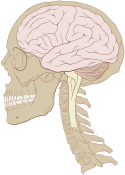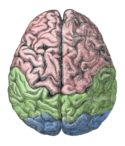Human brain
This article is about features specific to the human brain. For basic information about brains, see Brain.
[1] Most of the spatial expansion comes from the cerebral cortex, a convoluted layer of neural tissue which covers the surface of the forebrain. Especially expanded are the frontal lobes, which are associated with executive functions such as self-control, planning, reasoning, and abstract thought. The portion of the brain devoted to vision, the occipital lobe, is also greatly enlarged in human beings.Brain evolution, from the earliest shrew-like mammals through primates to hominids, is marked by a steady increase in encephalization, or the ratio of brain to body size. Estimates vary for the number of neuronal and non-neuronal cells contained in the brain, ranging from 80 or 90 billion (~85 109) non-neuronal cells (glial cells) and an approximately equal number of (~86 109) neurons,[2] of which about 10 billion (1010) are cortical pyramidal cells, to over 120 billion neuronal cells, with an approximately equal number of non-neuronal cells.[3] These cells pass signals to each other via as many as 1000 trillion (1015, 1 quadrillion) synaptic connections.[4] Due to evolution, however, the modern human brain has been shrinking over the past 28,000 years.


No comments:
Post a Comment